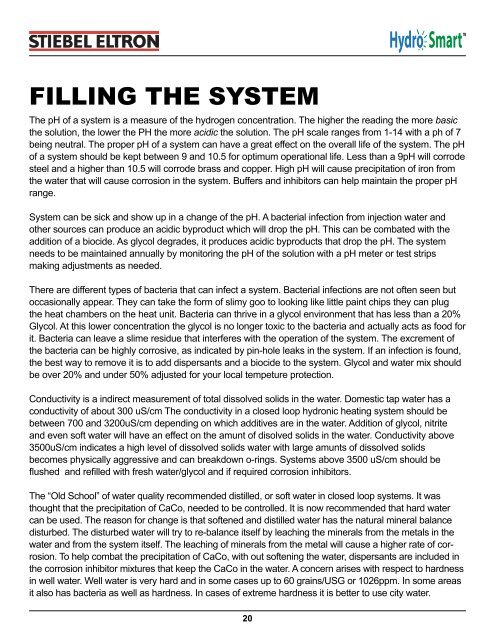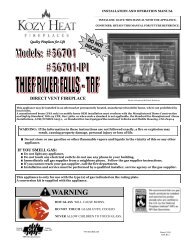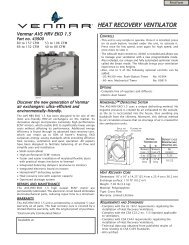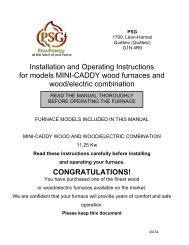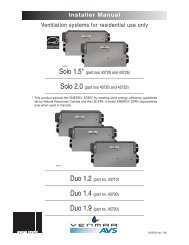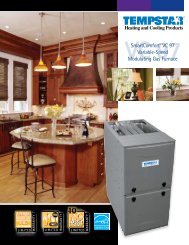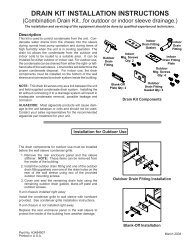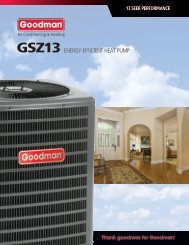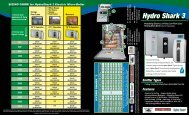modulating micro boilers - Hydro Smart
modulating micro boilers - Hydro Smart
modulating micro boilers - Hydro Smart
Create successful ePaper yourself
Turn your PDF publications into a flip-book with our unique Google optimized e-Paper software.
FILLING THE SYSTEMThe pH of a system is a measure of the hydrogen concentration. The higher the reading the more basicthe solution, the lower the PH the more acidic the solution. The pH scale ranges from 1-14 with a ph of 7being neutral. The proper pH of a system can have a great effect on the overall life of the system. The pHof a system should be kept between 9 and 10.5 for optimum operational life. Less than a 9pH will corrodesteel and a higher than 10.5 will corrode brass and copper. High pH will cause precipitation of iron fromthe water that will cause corrosion in the system. Buffers and inhibitors can help maintain the proper pHrange.System can be sick and show up in a change of the pH. A bacterial infection from injection water andother sources can produce an acidic byproduct which will drop the pH. This can be combated with theaddition of a biocide. As glycol degrades, it produces acidic byproducts that drop the pH. The systemneeds to be maintained annually by monitoring the pH of the solution with a pH meter or test stripsmaking adjustments as needed.There are different types of bacteria that can infect a system. Bacterial infections are not often seen butoccasionally appear. They can take the form of slimy goo to looking like little paint chips they can plugthe heat chambers on the heat unit. Bacteria can thrive in a glycol environment that has less than a 20%Glycol. At this lower concentration the glycol is no longer toxic to the bacteria and actually acts as food forit. Bacteria can leave a slime residue that interferes with the operation of the system. The excrement ofthe bacteria can be highly corrosive, as indicated by pin-hole leaks in the system. If an infection is found,the best way to remove it is to add dispersants and a biocide to the system. Glycol and water mix shouldbe over 20% and under 50% adjusted for your local tempeture protection.Conductivity is a indirect measurement of total dissolved solids in the water. Domestic tap water has aconductivity of about 300 uS/cm The conductivity in a closed loop hydronic heating system should bebetween 700 and 3200uS/cm depending on which additives are in the water. Addition of glycol, nitriteand even soft water will have an effect on the amunt of disolved solids in the water. Conductivity above3500uS/cm indicates a high level of dissolved solids water with large amunts of dissolved solidsbecomes physically aggressive and can breakdown o-rings. Systems above 3500 uS/cm should beflushed and refilled with fresh water/glycol and if required corrosion inhibitors.The “Old School” of water quality recommended distilled, or soft water in closed loop systems. It wasthought that the precipitation of CaCo, needed to be controlled. It is now recommended that hard watercan be used. The reason for change is that softened and distilled water has the natural mineral balancedisturbed. The disturbed water will try to re-balance itself by leaching the minerals from the metals in thewater and from the system itself. The leaching of minerals from the metal will cause a higher rate of corrosion.To help combat the precipitation of CaCo, with out softening the water, dispersants are included inthe corrosion inhibitor mixtures that keep the CaCo in the water. A concern arises with respect to hardnessin well water. Well water is very hard and in some cases up to 60 grains/USG or 1026ppm. In some areasit also has bacteria as well as hardness. In cases of extreme hardness it is better to use city water.20


